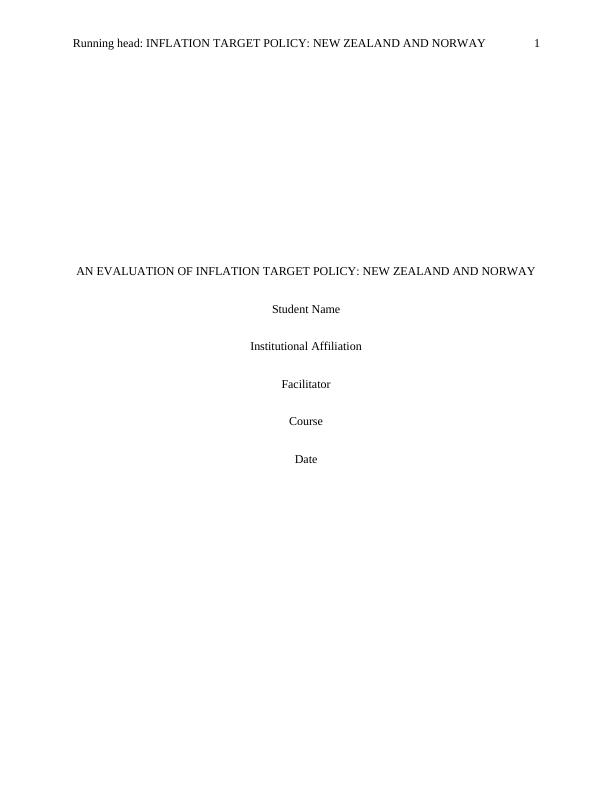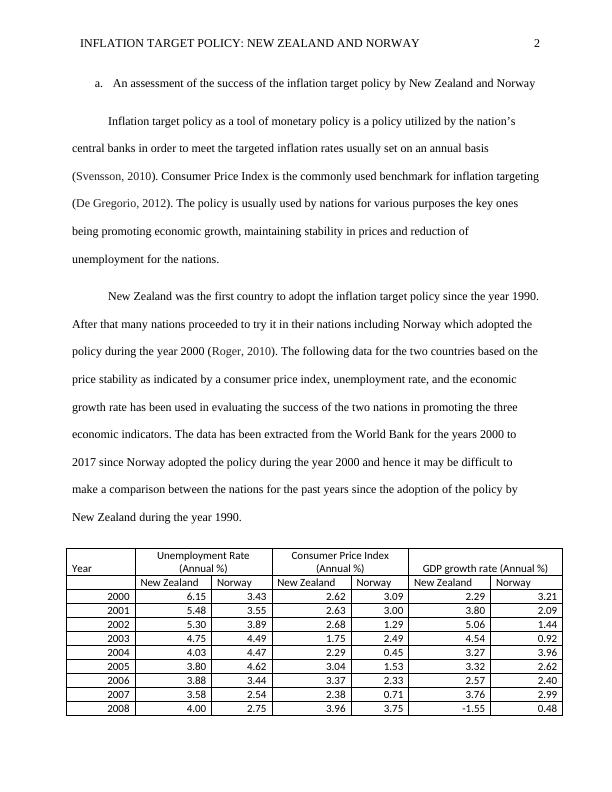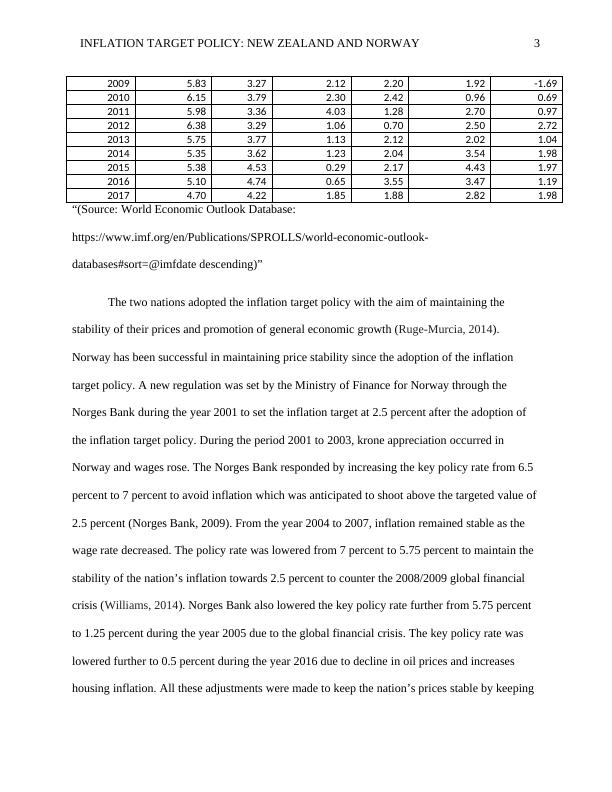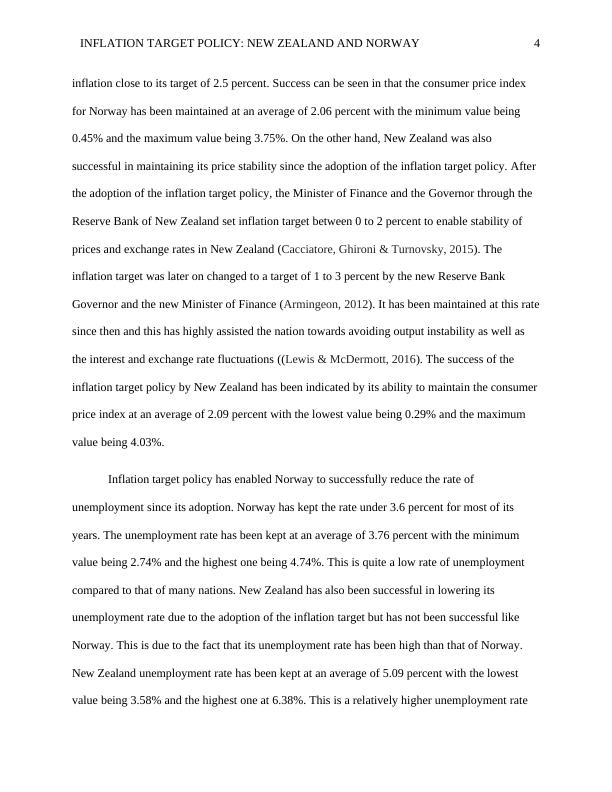An Evaluation of Inflation Target Policy: New Zealand and Norway
11 Pages3097 Words77 Views
Added on 2023-02-01
About This Document
This document evaluates the success of the inflation target policy in New Zealand and Norway, focusing on price stability, unemployment rate, and economic growth. It also discusses the challenges faced by Norway in implementing the policy and how both countries utilized fiscal policy during the 2008/2009 global financial crisis.
An Evaluation of Inflation Target Policy: New Zealand and Norway
Added on 2023-02-01
ShareRelated Documents
Running head: INFLATION TARGET POLICY: NEW ZEALAND AND NORWAY 1
AN EVALUATION OF INFLATION TARGET POLICY: NEW ZEALAND AND NORWAY
Student Name
Institutional Affiliation
Facilitator
Course
Date
AN EVALUATION OF INFLATION TARGET POLICY: NEW ZEALAND AND NORWAY
Student Name
Institutional Affiliation
Facilitator
Course
Date

INFLATION TARGET POLICY: NEW ZEALAND AND NORWAY 2
a. An assessment of the success of the inflation target policy by New Zealand and Norway
Inflation target policy as a tool of monetary policy is a policy utilized by the nation’s
central banks in order to meet the targeted inflation rates usually set on an annual basis
(Svensson, 2010). Consumer Price Index is the commonly used benchmark for inflation targeting
(De Gregorio, 2012). The policy is usually used by nations for various purposes the key ones
being promoting economic growth, maintaining stability in prices and reduction of
unemployment for the nations.
New Zealand was the first country to adopt the inflation target policy since the year 1990.
After that many nations proceeded to try it in their nations including Norway which adopted the
policy during the year 2000 (Roger, 2010). The following data for the two countries based on the
price stability as indicated by a consumer price index, unemployment rate, and the economic
growth rate has been used in evaluating the success of the two nations in promoting the three
economic indicators. The data has been extracted from the World Bank for the years 2000 to
2017 since Norway adopted the policy during the year 2000 and hence it may be difficult to
make a comparison between the nations for the past years since the adoption of the policy by
New Zealand during the year 1990.
Year
Unemployment Rate
(Annual %)
Consumer Price Index
(Annual %) GDP growth rate (Annual %)
New Zealand Norway New Zealand Norway New Zealand Norway
2000 6.15 3.43 2.62 3.09 2.29 3.21
2001 5.48 3.55 2.63 3.00 3.80 2.09
2002 5.30 3.89 2.68 1.29 5.06 1.44
2003 4.75 4.49 1.75 2.49 4.54 0.92
2004 4.03 4.47 2.29 0.45 3.27 3.96
2005 3.80 4.62 3.04 1.53 3.32 2.62
2006 3.88 3.44 3.37 2.33 2.57 2.40
2007 3.58 2.54 2.38 0.71 3.76 2.99
2008 4.00 2.75 3.96 3.75 -1.55 0.48
a. An assessment of the success of the inflation target policy by New Zealand and Norway
Inflation target policy as a tool of monetary policy is a policy utilized by the nation’s
central banks in order to meet the targeted inflation rates usually set on an annual basis
(Svensson, 2010). Consumer Price Index is the commonly used benchmark for inflation targeting
(De Gregorio, 2012). The policy is usually used by nations for various purposes the key ones
being promoting economic growth, maintaining stability in prices and reduction of
unemployment for the nations.
New Zealand was the first country to adopt the inflation target policy since the year 1990.
After that many nations proceeded to try it in their nations including Norway which adopted the
policy during the year 2000 (Roger, 2010). The following data for the two countries based on the
price stability as indicated by a consumer price index, unemployment rate, and the economic
growth rate has been used in evaluating the success of the two nations in promoting the three
economic indicators. The data has been extracted from the World Bank for the years 2000 to
2017 since Norway adopted the policy during the year 2000 and hence it may be difficult to
make a comparison between the nations for the past years since the adoption of the policy by
New Zealand during the year 1990.
Year
Unemployment Rate
(Annual %)
Consumer Price Index
(Annual %) GDP growth rate (Annual %)
New Zealand Norway New Zealand Norway New Zealand Norway
2000 6.15 3.43 2.62 3.09 2.29 3.21
2001 5.48 3.55 2.63 3.00 3.80 2.09
2002 5.30 3.89 2.68 1.29 5.06 1.44
2003 4.75 4.49 1.75 2.49 4.54 0.92
2004 4.03 4.47 2.29 0.45 3.27 3.96
2005 3.80 4.62 3.04 1.53 3.32 2.62
2006 3.88 3.44 3.37 2.33 2.57 2.40
2007 3.58 2.54 2.38 0.71 3.76 2.99
2008 4.00 2.75 3.96 3.75 -1.55 0.48

INFLATION TARGET POLICY: NEW ZEALAND AND NORWAY 3
2009 5.83 3.27 2.12 2.20 1.92 -1.69
2010 6.15 3.79 2.30 2.42 0.96 0.69
2011 5.98 3.36 4.03 1.28 2.70 0.97
2012 6.38 3.29 1.06 0.70 2.50 2.72
2013 5.75 3.77 1.13 2.12 2.02 1.04
2014 5.35 3.62 1.23 2.04 3.54 1.98
2015 5.38 4.53 0.29 2.17 4.43 1.97
2016 5.10 4.74 0.65 3.55 3.47 1.19
2017 4.70 4.22 1.85 1.88 2.82 1.98
“(Source: World Economic Outlook Database:
https://www.imf.org/en/Publications/SPROLLS/world-economic-outlook-
databases#sort=@imfdate descending)”
The two nations adopted the inflation target policy with the aim of maintaining the
stability of their prices and promotion of general economic growth (Ruge-Murcia, 2014).
Norway has been successful in maintaining price stability since the adoption of the inflation
target policy. A new regulation was set by the Ministry of Finance for Norway through the
Norges Bank during the year 2001 to set the inflation target at 2.5 percent after the adoption of
the inflation target policy. During the period 2001 to 2003, krone appreciation occurred in
Norway and wages rose. The Norges Bank responded by increasing the key policy rate from 6.5
percent to 7 percent to avoid inflation which was anticipated to shoot above the targeted value of
2.5 percent (Norges Bank, 2009). From the year 2004 to 2007, inflation remained stable as the
wage rate decreased. The policy rate was lowered from 7 percent to 5.75 percent to maintain the
stability of the nation’s inflation towards 2.5 percent to counter the 2008/2009 global financial
crisis (Williams, 2014). Norges Bank also lowered the key policy rate further from 5.75 percent
to 1.25 percent during the year 2005 due to the global financial crisis. The key policy rate was
lowered further to 0.5 percent during the year 2016 due to decline in oil prices and increases
housing inflation. All these adjustments were made to keep the nation’s prices stable by keeping
2009 5.83 3.27 2.12 2.20 1.92 -1.69
2010 6.15 3.79 2.30 2.42 0.96 0.69
2011 5.98 3.36 4.03 1.28 2.70 0.97
2012 6.38 3.29 1.06 0.70 2.50 2.72
2013 5.75 3.77 1.13 2.12 2.02 1.04
2014 5.35 3.62 1.23 2.04 3.54 1.98
2015 5.38 4.53 0.29 2.17 4.43 1.97
2016 5.10 4.74 0.65 3.55 3.47 1.19
2017 4.70 4.22 1.85 1.88 2.82 1.98
“(Source: World Economic Outlook Database:
https://www.imf.org/en/Publications/SPROLLS/world-economic-outlook-
databases#sort=@imfdate descending)”
The two nations adopted the inflation target policy with the aim of maintaining the
stability of their prices and promotion of general economic growth (Ruge-Murcia, 2014).
Norway has been successful in maintaining price stability since the adoption of the inflation
target policy. A new regulation was set by the Ministry of Finance for Norway through the
Norges Bank during the year 2001 to set the inflation target at 2.5 percent after the adoption of
the inflation target policy. During the period 2001 to 2003, krone appreciation occurred in
Norway and wages rose. The Norges Bank responded by increasing the key policy rate from 6.5
percent to 7 percent to avoid inflation which was anticipated to shoot above the targeted value of
2.5 percent (Norges Bank, 2009). From the year 2004 to 2007, inflation remained stable as the
wage rate decreased. The policy rate was lowered from 7 percent to 5.75 percent to maintain the
stability of the nation’s inflation towards 2.5 percent to counter the 2008/2009 global financial
crisis (Williams, 2014). Norges Bank also lowered the key policy rate further from 5.75 percent
to 1.25 percent during the year 2005 due to the global financial crisis. The key policy rate was
lowered further to 0.5 percent during the year 2016 due to decline in oil prices and increases
housing inflation. All these adjustments were made to keep the nation’s prices stable by keeping

INFLATION TARGET POLICY: NEW ZEALAND AND NORWAY 4
inflation close to its target of 2.5 percent. Success can be seen in that the consumer price index
for Norway has been maintained at an average of 2.06 percent with the minimum value being
0.45% and the maximum value being 3.75%. On the other hand, New Zealand was also
successful in maintaining its price stability since the adoption of the inflation target policy. After
the adoption of the inflation target policy, the Minister of Finance and the Governor through the
Reserve Bank of New Zealand set inflation target between 0 to 2 percent to enable stability of
prices and exchange rates in New Zealand (Cacciatore, Ghironi & Turnovsky, 2015). The
inflation target was later on changed to a target of 1 to 3 percent by the new Reserve Bank
Governor and the new Minister of Finance (Armingeon, 2012). It has been maintained at this rate
since then and this has highly assisted the nation towards avoiding output instability as well as
the interest and exchange rate fluctuations ((Lewis & McDermott, 2016). The success of the
inflation target policy by New Zealand has been indicated by its ability to maintain the consumer
price index at an average of 2.09 percent with the lowest value being 0.29% and the maximum
value being 4.03%.
Inflation target policy has enabled Norway to successfully reduce the rate of
unemployment since its adoption. Norway has kept the rate under 3.6 percent for most of its
years. The unemployment rate has been kept at an average of 3.76 percent with the minimum
value being 2.74% and the highest one being 4.74%. This is quite a low rate of unemployment
compared to that of many nations. New Zealand has also been successful in lowering its
unemployment rate due to the adoption of the inflation target but has not been successful like
Norway. This is due to the fact that its unemployment rate has been high than that of Norway.
New Zealand unemployment rate has been kept at an average of 5.09 percent with the lowest
value being 3.58% and the highest one at 6.38%. This is a relatively higher unemployment rate
inflation close to its target of 2.5 percent. Success can be seen in that the consumer price index
for Norway has been maintained at an average of 2.06 percent with the minimum value being
0.45% and the maximum value being 3.75%. On the other hand, New Zealand was also
successful in maintaining its price stability since the adoption of the inflation target policy. After
the adoption of the inflation target policy, the Minister of Finance and the Governor through the
Reserve Bank of New Zealand set inflation target between 0 to 2 percent to enable stability of
prices and exchange rates in New Zealand (Cacciatore, Ghironi & Turnovsky, 2015). The
inflation target was later on changed to a target of 1 to 3 percent by the new Reserve Bank
Governor and the new Minister of Finance (Armingeon, 2012). It has been maintained at this rate
since then and this has highly assisted the nation towards avoiding output instability as well as
the interest and exchange rate fluctuations ((Lewis & McDermott, 2016). The success of the
inflation target policy by New Zealand has been indicated by its ability to maintain the consumer
price index at an average of 2.09 percent with the lowest value being 0.29% and the maximum
value being 4.03%.
Inflation target policy has enabled Norway to successfully reduce the rate of
unemployment since its adoption. Norway has kept the rate under 3.6 percent for most of its
years. The unemployment rate has been kept at an average of 3.76 percent with the minimum
value being 2.74% and the highest one being 4.74%. This is quite a low rate of unemployment
compared to that of many nations. New Zealand has also been successful in lowering its
unemployment rate due to the adoption of the inflation target but has not been successful like
Norway. This is due to the fact that its unemployment rate has been high than that of Norway.
New Zealand unemployment rate has been kept at an average of 5.09 percent with the lowest
value being 3.58% and the highest one at 6.38%. This is a relatively higher unemployment rate

End of preview
Want to access all the pages? Upload your documents or become a member.
Related Documents
Inflation Targeting Policy: A Comparative Analysislg...
|12
|2541
|422
ECON6001 Economic Principleslg...
|17
|3124
|44
